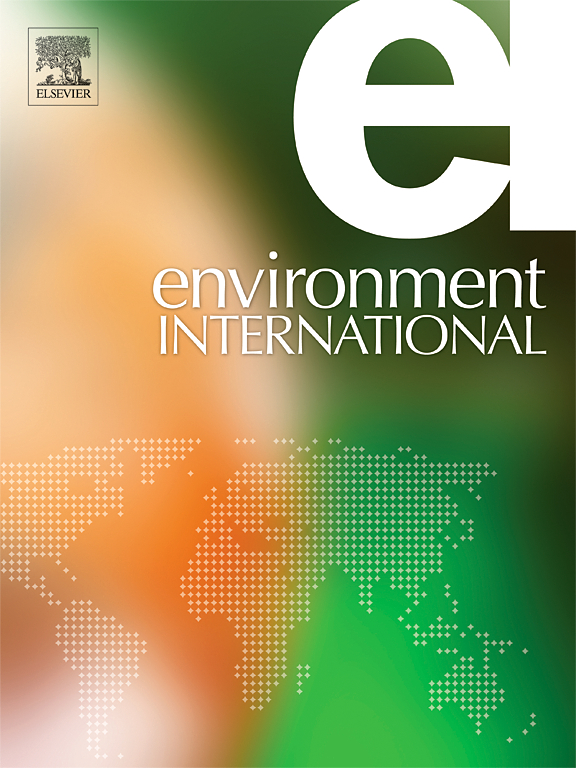全氟烷基和多氟烷基物质与大鼠肝脏和血清蛋白的结合:基于生理的药代动力学建模的意义
IF 9.7
1区 环境科学与生态学
Q1 ENVIRONMENTAL SCIENCES
引用次数: 0
摘要
了解全氟烷基和多氟烷基物质(PFAS)与蛋白质之间的结合对于阐明其毒性动力学和组织分布至关重要。在这里,我们量化了14种PFAS与大鼠肝脏脂肪酸结合蛋白(rL-FABP)和大鼠血清白蛋白(RSA)的结合亲和力。结果表明,PFAS对rL-FABP具有很强的结合亲和力(Ka)(103 ~ 105 M−1),特别是在中至长链全氟羧酸(PFCAs)之间。PFAS与RSA的结合亲和力约为104 ~ 105 M−1,有1 ~ 4个结合位点。分子对接结果支持PFAS与蛋白质的结合是一个由范德华力、氢键和静电相互作用驱动的放热过程。此外,长链PFCAs在rL-FABP和RSA的配体结合腔内呈“U”形构象。新开发的基于生理的药代动力学模型使用测量的结合数据显示,与实验观察结果的拟合优度有了实质性的改善,将预测误差降低了20 % ~ 216 %。最后,我们发现PFAS的肝血分离主要可以通过PFAS与肝脏和血液蛋白的结合亲和力比值来解释,这可以进一步从大鼠到人的外推,为了解PFAS的组织分布提供了有用的见解。本文章由计算机程序翻译,如有差异,请以英文原文为准。


Binding of per- and polyfluoroalkyl substances with liver and serum proteins in rats: implications for physiologically based pharmacokinetic modelling
Understanding the binding between per- and polyfluoroalkyl substances (PFAS) and proteins is essential for elucidating their toxicokinetics and tissue distribution. Here, we quantified the binding affinities of 14 PFAS to rat liver fatty acid-binding protein (rL-FABP) and rat serum albumin (RSA). Results showed that PFAS exhibit strong binding affinities (Ka) to the rL-FABP (103 ∼ 105 M−1), particularly among medium- to long-chain perfluorinated carboxylic acids (PFCAs). The binding affinity of PFAS to RSA ranged from approximately 104 to 105 M−1, with 1 to 4 binding sites. Molecular docking results supported that PFAS binding to proteins is an exothermic process driven by van der Waals forces, hydrogen bonding, and electrostatic interactions. Additionally, long-chain PFCAs were shown to adopt a “U”-shaped conformation within the ligand-binding cavities of rL-FABP and RSA. The newly developed physiologically based pharmacokinetic model using measured binding data demonstrates a substantial improvement in the goodness of fit to experimental observations, reducing the prediction error by 20 %∼216 %. Finally, we found that the PFAS liver-blood partition could be mainly explained by the binding affinity ratios of PFAS to liver and blood proteins, which could be further extrapolated from rats to humans, providing useful insights to understand the tissue distribution of PFAS.
求助全文
通过发布文献求助,成功后即可免费获取论文全文。
去求助
来源期刊

Environment International
环境科学-环境科学
CiteScore
21.90
自引率
3.40%
发文量
734
审稿时长
2.8 months
期刊介绍:
Environmental Health publishes manuscripts focusing on critical aspects of environmental and occupational medicine, including studies in toxicology and epidemiology, to illuminate the human health implications of exposure to environmental hazards. The journal adopts an open-access model and practices open peer review.
It caters to scientists and practitioners across all environmental science domains, directly or indirectly impacting human health and well-being. With a commitment to enhancing the prevention of environmentally-related health risks, Environmental Health serves as a public health journal for the community and scientists engaged in matters of public health significance concerning the environment.
 求助内容:
求助内容: 应助结果提醒方式:
应助结果提醒方式:


